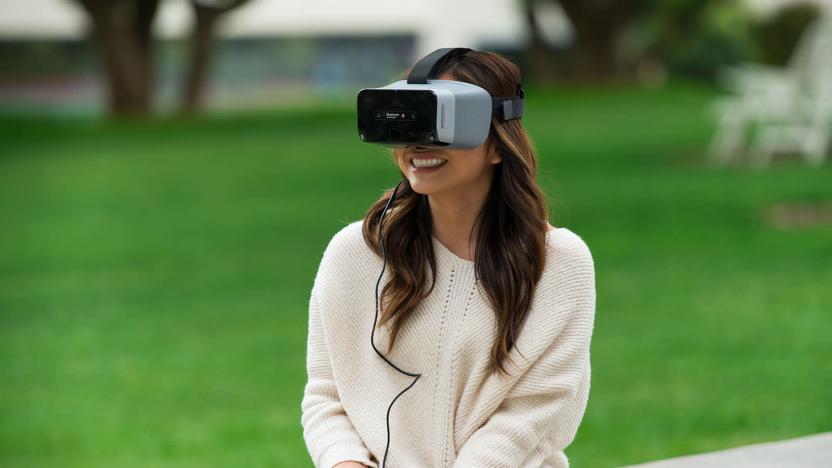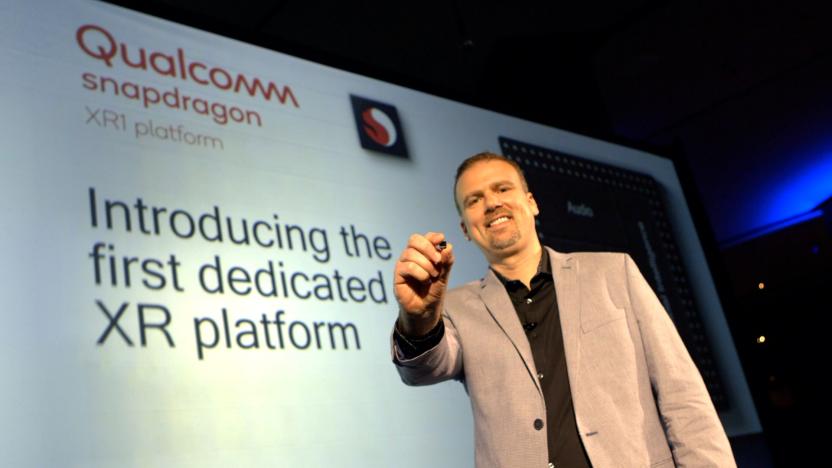xr1
Latest

Qualcomm has a new reference headset to help fast-track AR development
Qualcomm pulled back the curtain on a mixed reality headset design based on its high-powered XR2 chipset around this time last year, but it still isn’t done with the processor that precedes that one. The company announced today that it will release a new, XR1-powered headset reference design, and usual, you’ll probably never be able to get your hands on one of these things. It’s being distributed to “select partners” right now, and the next batch of XR hardware developers will be able to claim theirs in the coming months.

Qualcomm made a headset to remind the world it has an AR chip
Last year, Qualcomm unveiled the Snapdragon XR1 chip just for virtual reality devices, but so far, we haven't seen any headsets built to use it. Now, for Augmented World Expo, the company has released its own "Smart Viewer Reference Design" headset in order to reduce AR and VR headset development time. It looks to hold a lot of potential, packing just about every feature you'd want in a VR/AR wearable.

Microsoft's HoloLens 2 will use Qualcomm's new XR1 VR chip
Update: HoloLens 2 launched at Mobile World Congress 2019 with the Snapdragon 850 instead of the XR1. The original post follows. There's been a lot of speculation lately about the next generation of Microsoft's augmented reality headset. Everyone is talking about when HoloLens 2 will arrive, how much it will cost, and what exactly will be lurking inside. And we might just have some answers, thanks to a source familiar with the matter.

Qualcomm built a chip to power AR and VR headsets
Qualcomm's Snapdragon chips have powered devices from smartphones and laptops to VR headsets, but the company is doing away with repurposing mobile processors for mixed reality devices. The company just released the Snapdragon XR1 -- its first "dedicated Extended Reality (XR) platform," and it's a chipset designed specifically for AR and VR headsets. XR1 is meant to offer better experiences on mainstream devices by enabling high-quality visual and audio playback, as well as 3-DoF and 6-DoF interactive controls. Qualcomm also announced that companies like Meta, Vive, Vuzix and Pico are already working on devices using the XR1 chip, and those products could potentially be ready as early as this year, depending on each partner.

Sony's 1,000,000:1 contrast BRAVIAs launch in Japan October 10
Sony's XBR6 / XBR7 / XBR8 models are still waiting in the wings for their U.S. debut, but along with HDTVs that push the extremes in thin and fast, the company announced these more conventional models it's deemed "the highest quality BRAVIA HDTVs in history." The XR1 (read: XBR8) series will feature a 1,000,000:1 dynamic contrast ratio (3,000:1 static) courtesy of those new TRILUMINOS three-color LEDs, 10-bit BRAVIA Engine 2 processing and Motionflow 120Hz technology. If you can live without 240Hz or WHDI, the 1080p 55-inch edition runs ¥750,000 ($6,489 U.S.) with a 46-inch for ¥600,000 ($5,479 U.S.). The next level down is the X1 (read: XBR6 / XBR7) series, based on old school CCFL backlights limited to a 3,000:1 contrast rating, ranging in size from 40- to 52- inches and in price from ¥530,000 ($4,866 U.S.) to ¥320,000 ($2,922 U.S.) when they go on sale October 10. Digital Media Extender support, DLNA connectivity and all the other high end feature's make their expected appearance across the lineup. With fears of watered down technology effectively quelled, Sony wouldn't make us wait until October to find out when we can buy an HDTV in the U.S. or Europe from this lineup -- somehow we doubt it.




